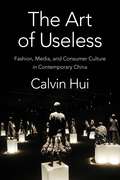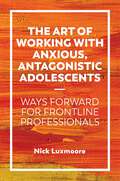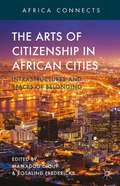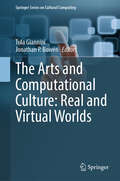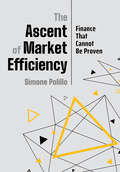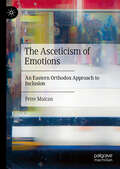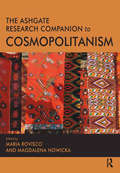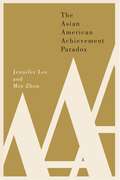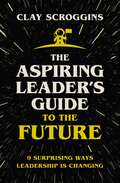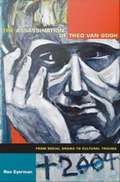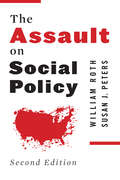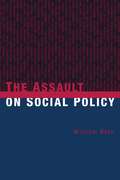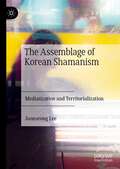- Table View
- List View
The Art of Thinking Clearly: Better Thinking, Better Decisions
by Rolf DobelliTHE SUNDAY TIMES BESTSELLERTHE TIMES BESTSELLERMAIL ON SUNDAY BESTSELLERGUARDIAN BESTSELLER AMAZON TOP TEN BESTSELLERLIVE MAGAZINE BESTSELLERIRISH TIMES NUMBER 1 BESTSELLERTHE SECRETS OF PERFECT DECISION-MAKINGHave you ever...Invested time in something that, with hindsight, just wasn't worth it?Overpayed in an Ebay auction?Continued doing something you knew was bad for you?Sold stocks too late, or too early?Taken credit for success, but blamed failure on external circumstances?Backed the wrong horse?These are examples of cognitive biases, simple errors we all make in our day-to-day thinking. But by knowing what they are and how to spot them, we can avoid them and make better choices - whether dealing with a personal problem or a business negotiation; trying to save money or make money; working out what we do or don't want in life, and how best to get it.Already an international bestseller, THE ART OF THINKING CLEARLY is essential reading for anyone with important decisions to make. It reveals, in 100 short chapters, the most common errors of judgement, and how to avoid them. Simple, clear and always surprising, this indispensable book will change the way you think and transform your decision-making - at work, at home, every day.(P)2013 Hodder & Stoughton
The Art of Useless: Fashion, Media, and Consumer Culture in Contemporary China (Global Chinese Culture)
by Calvin HuiSince embarking on economic reforms in 1978, the People’s Republic of China has also undergone a sweeping cultural reorganization, from proletarian culture under Mao to middle-class consumer culture today. Under these circumstances, how has a Chinese middle class come into being, and how has consumerism become the dominant ideology of an avowedly socialist country? The Art of Useless offers an innovative way to understand China’s unprecedented political-economic, social, and cultural transformations, showing how consumer culture helps anticipate, produce, and shape a new middle-class subjectivity.Examining changing representations of the production and consumption of fashion in documentaries and films, Calvin Hui traces how culture contributes to China’s changing social relations through the cultivation of new identities and sensibilities. He explores the commodity chain of fashion on a transnational scale, from production to consumption to disposal, as well as media portrayals of the intersections of clothing with class, gender, and ethnicity. Hui illuminates key cinematic narratives, such as a factory worker’s desire for a high-quality suit in the 1960s, an intellectual’s longing for fashionable clothes in the 1980s, and a white-collar woman’s craving for brand-name commodities in the 2000s. He considers how documentary films depict the undersides of consumption—exploited laborers who fantasize about the products they manufacture as well as the accumulation of waste and its disposal—revealing how global capitalism renders migrant factory workers, scavengers, and garbage invisible.A highly interdisciplinary work that combines theoretical nuance with masterful close analyses, The Art of Useless is an innovative rethinking of the emergence of China’s middle-class consumer culture.
The Art of Working with Anxious, Antagonistic Adolescents: Ways Forward for Frontline Professionals
by Nick LuxmooreThe conversations in this book illuminate therapeutic methods. Focused on teenage pastoral care and formed of discussions between veteran counsellor Nick Luxmoore and frontline professionals, it gives rise to new understanding in the art of working with today's adolescents, in a way that is engaging, strikingly frank, and always instructive.
The Art-Science Symbiosis
by Marcelo Velasco Ignacio NietoThis book delves into the long-standing human aspiration to combine art and science. In six chapters, The Art-Science Symbiosis outlines new approaches to understand current scientific practice in general and art-science in particular, showcasing how contemporary art can provide a unique perspective on the meaning and potential of collaboration. With more than a hundred full colour images, The Art-Science Symbiosis serves as a resource for researchers interested in the art-science integration, as well as a general reference for interdisciplinary and transdisciplinary work.In the book, twenty-two works have been selected based on their inherent merits and for the emergent knowledge that their art-science integration produces. These works have sparked novel questions, ideas and curiosity amongst scientists and artists alike which, we hope, will promote further dialogue not only amongst them but with the general public, inspiring a process that may leadto diverse, complex, and promising results with real-world consequences we have as yet to uncover.The Key messages of the book are:● Contemporary art is a powerful space of dialogue between science and the public● Interdisciplinary work based on symmetrical collaboration promotes groundbreaking results● Artistic inquiry can lead to new understanding of scientific exploration● Art-science practice could be started using a simple methodology
The Artefacts of Digital Mental Health (Health, Technology and Society)
by Jacinthe FloreThe Artefacts of Digital Mental Health focuses on smartphone apps, wearables devices, and ingestible sensors, which are at the centre of research, development, and investment in mental health and digitalisation. The book aims to examine digital mental health through three artefacts that are defined by their ubiquity, everydayness, popularity, innovation and hype, and emergent qualities. It engages with theoretical approaches to technology, mental health, and wellbeing informed by Science and Technology Studies, sociological studies of health and mental health, and sociomaterialism. The book brings together different theories of mental health, subjectivity, the body, care, and digitalisation alongside biodigital artefacts as exemplars of transformations in digital mental health.
The Arthurdale School: Cultural Intervention Through Rural Folklife Education in a Progressive New Deal Setting
by Jan RosenbergThis book chronicles the school envisioned by Eleanor Roosevelt in 1933 to serve Arthurdale, the New Deal government-created community in north-central West Virginia. Arthurdale was founded to house unemployed miners and their families and provide them with opportunities to receive healthcare and obtain gainful employment. Roosevelt had a particular interest in the education of children, feeling that education and social life were profoundly intertwined within a community. With that in mind, in 1934, she hired Elsie Ripley Clapp—an educator and leader in the Progressive Education movement—to design and implement the school, as well as oversee the social life of Arthurdale as a whole. In addition to covering the Arthurdale School's birth, life, and dissolution, Rosenberg discusses how the lessons of the school might serve the culture of education today, especially as an element of a comprehensive approach to community revitalization.
The Arts Of Citizenship In African Cities
by Mamadou Diouf Rosalind FredericksThe Arts of Citizenship in African Cities pushes the frontiers of how we understand cities and citizenship and offers new perspectives on African urbanism. Nuanced ethnographic analyses of life in an array of African cities illuminate the emergent infrastructures and spaces of belonging through which urban lives and politics are being forged.
The Arts and Computational Culture: Real and Virtual Worlds (Springer Series on Cultural Computing)
by Jonathan P. Bowen Tula GianniniA Paradigm Shift and Defining Moment in the 21st Century: Fuelled by the convergence of computational culture, artificial intelligence, and machine learning, arts and culture are experiencing a revolutionary moment poised to change human life and society on a global scale. There is the promise of the Metaverse, with extended reality (XR) and immersive virtual worlds. For the first time, reality and virtuality are merging with these new developments. The proposed book is among the first to address the context, complexity, and impact of this multi-faceted subject in detail – for up close and personal engagement of the reader, while evoking a landscape view. As digital culture evolves to computational culture, we embark on a digital journey from 2D to 3D, where flat computer screens for the Internet and smart phones are evolving into immersive digital environments. This is while new technologies and AI are increasingly embedded in every aspect of daily life, the arts, and education.
The Ascent of Market Efficiency: Finance That Cannot Be Proven
by Simone PolilloThe Ascent of Market Efficiency weaves together historical narrative and quantitative bibliometric data to detail the path financial economists took in order to form one of the central theories of financial economics—the influential efficient-market hypothesis—which states that the behavior of financial markets is unpredictable.As the notorious quip goes, a blindfolded monkey would do better than a group of experts in selecting a portfolio of securities, simply by throwing darts at the financial pages of a newspaper. How did such a hypothesis come to be so influential in the field of financial economics? How did financial economists turn a lack of evidence about systematic patterns in the behavior of financial markets into a foundational approach to the study of finance?Each chapter in Simone Polillo's fascinating meld of economics, science, and sociology focuses on these questions, as well as on collaborative academic networks, and on the values and affects that kept the networks together as they struggled to define what the new field of financial economics should be about. In doing so, he introduces a new dimension—data analysis—to our understanding of the ways knowledge advances.There are patterns in the ways knowledge is produced, and The Ascent of Market Efficiency helps us make sense of these patterns by providing a general framework that can be applied equally to other social and human sciences.
The Asceticism of Emotions: An Eastern Orthodox Approach to Inclusion
by Petre MaicanThis book delves into the profound challenges posed by the negative emotions—fear, pity, and disgust—that persons with atypical bodies often evoke in their non-disabled peers. It seeks to uncover the theological roots of these reactions and offers a transformative path for overcoming them. Drawing deeply from the ascetical tradition of the Eastern Orthodox Church, the book highlights centuries of rich insights into the dynamics of emotions and their spiritual transformation. By engaging with this tradition, the book provides a nuanced understanding of how emotions shape human perception and interaction, particularly in the context of disability. More than just an exploration of aesthetics, emotions, and asceticism, this work enriches the field of disability theology through a constructive dialogue with the Eastern Orthodox tradition. Long underrepresented in the discussions on disability, Eastern Orthodoxy reveals here its resources for reimagining inclusion and human dignity.
The Asheville Reader: The Ancient World
by Brian S. Hook Merritt W. Moseley Kathleen W. PetersThe Asheville Reader: The Ancient World was created to be used in the first course in the Humanities sequence at the University of North Carolina at Asheville. Humanities is a multi-course, interdisciplinary program in culture, ideas, sensations, and social movements. At the center of Humanities is the students encounter with primary works.
The Ashgate Handbook of Pesticides and Agricultural Chemicals (Routledge Revivals Ser.)
by G W A MilneThis title was first published in 2000: Pesticides and other agricultural chemicals are in use in virtually every country in the world. It is therefore useful and important to those involved with these chemicals to have a collection of data concerning the substances most commonly used for agricultural purposes. This Handbook includes data on over 1,800 substances, including a number of mixtures, which are important in agriculture. Almost all records describing pure chemicals carry the appropriate CAS Registry Number and the associated EINECS Number. All chemicals in this edition which also appear in the twelfth edition of the Merck Index have the Merck Index Number provided. Wherever possible, the following information is also provided for each entry: definitions, classifications, chemical composition, functions, applications, suppliers, melting point, boiling point, density or specific gravity, refractive index, optical rotation, ultraviolet absorption, solubility, and acute toxicity.
The Ashgate Research Companion to Cosmopolitanism
by Maria RoviscoThe study of Cosmopolitanism has been transformed in the last 20 years and the subject itself has become highly discussed across the social sciences and the humanities. The Ashgate Research Companion to Cosmopolitanism pursues distinct theoretical orientations and empirical analyses, bringing together mainstream discussions with the newest thinking and developments on the main themes, debates and controversies surrounding the subject. The contributions are grouped into three parts, each reflecting a different analytical focus within a variety of intellectual disciplines and methodological approaches. Part I (Cultural Cosmopolitanism) is primarily concerned with the empirically-grounded aspects of cosmopolitanism which are apparent in mundane practices and lifestyle options on the micro-scale of daily interactions. It focuses on the outlooks and lived experience of ordinary individuals and groups in concrete situational contexts and social structures. Part II (Political Cosmopolitanism) sets out the main topics and issues dealt with by scholars writing within the tradition of political cosmopolitanism. Addressing timely issues such as human rights, global justice, and global democracy, it focuses on Cosmopolitanism as an ethico-political ideal and a political project to devise new forms of supranational and transnational governance. Part III (Debates) reflects the major debates and controversies on the subject and deliberately eschews any bland consensus to instead foreground the key arguments and lively intellectual discussions in play across disciplinary divisions. Featuring contributions from key thinkers in the field, including Ulrich Beck, David Held and Martha Nussbaum, this comprehensive volume will be a valuable resource for all academics and students working within this area of study.
The Ashgate Research Companion to Memory Studies
by Siobhan KattagoMemory has long been a subject of fascination for poets, artists, philosophers and historians. This timely volume, edited by Siobhan Kattago, examines how past events are remembered, contested, forgotten, learned from and shared with others. Each author in The Ashgate Research Companion to Memory Studies has been asked to reflect on his or her research companions as a scholar, who studies memory. The original studies presented in the volume are written by leading experts, who emphasize both the continuity of heritage and tradition, as well as the memory of hostilities, traumas and painful events. Comprised of four thematic sections, The Ashgate Research Companion to Memory Studies provides a comprehensive overview of the latest research within the discipline. The principal themes include: ¢ Memory, History and Time ¢ Social, Psychological and Cultural Frameworks of Memory ¢ Acts and Places of Memory ¢ Politics of Memory, Forgetting and Democracy Featuring contributions from key thinkers in the field, this comprehensive volume will be a valuable resource for all academics and students working within this area of study.
The Ashgate Research Companion to Moral Panics
by Charles KrinskyThe Ashgate Research Companion to Moral Panics offers a comprehensive assemblage of cutting-edge critical and theoretical perspectives on the concept of moral panic. All chapters represent original research by many of the most influential theorists and researchers now working in the area of moral panic, including Nachman Ben-Yehuda and Erich Goode, Joel Best, Chas Critcher, Mary deYoung, Alan Hunt, Toby Miller, Willem Schinkel, Kenneth Thompson, Sheldon Ungar, and Grazyna Zajdow. Chapters come from a range of disciplines, including media studies, literary studies, history, legal studies, and sociology, with significant new elaborations on the concept of moral panic (and its future), informed and powerful critiques, and detailed empirical studies from several continents. A clear and comprehensive survey of a concept that is increasingly influential in a number of disciplines as well as in popular culture, this collection of the latest research in the field addresses themes including the evolution of the moral panic concept, sex panics, media panics, moral panics over children and youth, and the future of the moral panic concept.
The Asian American Achievement Paradox
by Jennifer Lee Min ZhouAsian Americans are often stereotyped as the “model minority.” Their sizeable presence at elite universities and high household incomes have helped construct the narrative of Asian American “exceptionalism.” While many scholars and activists characterize this as a myth, pundits claim that Asian Americans’ educational attainment is the result of unique cultural values. In The Asian American Achievement Paradox, sociologists Jennifer Lee and Min Zhou offer a compelling account of the academic achievement of the children of Asian immigrants. Drawing on in-depth interviews with the adult children of Chinese immigrants and Vietnamese refugees and survey data, Lee and Zhou bridge sociology and social psychology to explain how immigration laws, institutions, and culture interact to foster high achievement among certain Asian American groups. For the Chinese and Vietnamese in Los Angeles, Lee and Zhou find that the educational attainment of the second generation is strikingly similar, despite the vastly different socioeconomic profiles of their immigrant parents. Because immigration policies after 1965 favor individuals with higher levels of education and professional skills, many Asian immigrants are highly educated when they arrive in the United States. They bring a specific “success frame,” which is strictly defined as earning a degree from an elite university and working in a high-status field. This success frame is reinforced in many local Asian communities, which make resources such as college preparation courses and tutoring available to group members, including their low-income members. While the success frame accounts for part of Asian Americans’ high rates of achievement, Lee and Zhou also find that institutions, such as public schools, are crucial in supporting the cycle of Asian American achievement. Teachers and guidance counselors, for example, who presume that Asian American students are smart, disciplined, and studious, provide them with extra help and steer them toward competitive academic programs. These institutional advantages, in turn, lead to better academic performance and outcomes among Asian American students. Yet the expectations of high achievement come with a cost: the notion of Asian American success creates an “achievement paradox” in which Asian Americans who do not fit the success frame feel like failures or racial outliers. While pundits ascribe Asian American success to the assumed superior traits intrinsic to Asian culture, Lee and Zhou show how historical, cultural, and institutional elements work together to confer advantages to specific populations. An insightful counter to notions of culture based on stereotypes, The Asian American Achievement Paradox offers a deft and nuanced understanding how and why certain immigrant groups succeed.
The Asian Tsunami and Post-Disaster Aid
by Sunita ReddyThrough the lens of the Asian tsunami, this book problematizes concepts that are normally taken for granted in disaster discourse, including relief, recovery, reconstruction and rehabilitation. The unprecedented flow of humanitarian aid after the Asian tsunami, though well-intentioned, showed adverse effects and unintended consequences in the lives of people in the communities across nations. Aid led not only to widespread relief and recovery but also to an exacerbation of old forms of inequities and the creation of new ones arising from the prioritization, distribution and management of aid. This, in turn, led to the incongruity between the needs and expectations of the affected and the agendas of aid agencies and their various intermediaries. This book examines the long-term consequences of post-disaster aid by posing the following questions: What has the aid been expended on? Where has the aid primarily been expended, and how? And what were the unintended consequences of post-disaster aid for the communities? This topical volume is of interest to social scientists, human rights and law researchers and environmental scientists interested in disaster studies.
The Aspiring Leader's Guide to the Future: 9 Surprising Ways Leadership is Changing
by Clay ScrogginsYou may not hold a position of leadership or think of yourself as a leader. But if you want to create, change, or impact the world around you—even in a modest way—then you're guided by a leader's impulse and shaped by a leader's principles.You are an aspiring leader.But the fact is that you've come to this role at a time when leadership—like everything else—is rapidly changing...and too many leaders are addressing the problems of today and tomorrow with the style and substance of yesterday's leadership. We need an update.In The Aspiring Leader's Guide to the Future, Clay Scroggins (author of How to Lead When You're Not in Charge) explores nine new principles of leadership that will help leaders adapt to a changing world and work culture, such as:Today's leaders lean into vulnerability.Today's leaders develop relationships primarily around trust.Today's leaders celebrate the successes of others.These may seem like counter-intuitive principles, but they provide a new way forward for leaders and teams and will prove versatile in the event of change and durable in the face of conflict. With humor and a pastor's candor, Clay will show you why the old ways need updating and what developing new leadership skills could look like for your future.To be clear, the author of this book does not know the future. If he did, he would have used his talents on sports betting or stock trading. What he does know is that yesterday's leadership axioms are today's myths and what that means. The way forward requires an understanding of the past, a conviction of what's at stake today, and a vision for how different tomorrow will be.You don't have to be a young entrepreneur with big dreams or someone looking to land a leadership role just to be considered an aspiring leader. You are one now. And by developing your skills for the future, you can become today's version of a leader worth following.
The Assassination of John F. Kennedy: Political Trauma and American Memory
by Alice GeorgeOn November 22nd, 1963 the assassination of President John F. Kennedy set into motion a series of events that irrevocably changed American politics and culture. The media frenzy spawned by the controversy surrounding the death of JFK has since given way to a powerful public memory that continues to shape the way we understand politics, the 1960s, and the nation. In The Assassination of John F. Kennedy: Political Trauma and American Memory, Alice George traces the events of Kennedy's assassination and Lyndon B. Johnson's subsequent ascension to the presidency. Covering both the political shifts of the time and the cultural fallout of the national tragedy, this book introduces students of the twenty-first century to both an iconic event and to the context in which that event was heralded as iconic. Drawing on newspaper articles, political speeches, letters, and diaries, George critically re-examines the event of JFK's death and its persistent political and cultural legacy.
The Assassination of Theo Van Gogh: From Social Drama to Cultural Trauma
by Ron EyermanIn November 2004, the controversial Dutch filmmaker Theo van Gogh was killed on a busy street in Amsterdam. A twenty-six-year-old Dutch citizen of Moroccan descent shot van Gogh, slit his throat, and pinned a five-page indictment of Western society to his body. The murder set off a series of reactions, including arson against Muslim schools and mosques. In The Assassination of Theo van Gogh, Ron Eyerman explores the multiple meanings of the murder and the different reactions it elicited: among the Amsterdam-based artistic and intellectual subculture, the wider Dutch public, the local and international Muslim communities, the radical Islamic movement, and the broader international community. After meticulously analyzing the actions and reputations of van Gogh and others in his milieu, the motives of the murderer, and the details of the assassination itself, Eyerman considers the various narrative frames the mass media used to characterize the killing. Eyerman utilizes theories of social drama and cultural trauma to evaluate the reactions to and effects of the murder. A social drama is triggered by a public transgression of taken-for-granted norms; one that threatens the collective identity of a society may develop into a cultural trauma. Eyerman contends that the assassination of Theo van Gogh quickly became a cultural trauma because it resonated powerfully with the postwar psyche of the Netherlands. As part of his analysis of the murder and reactions to it, he discusses significant aspects of twentieth-century Dutch history, including the country's treatment of Jews during the German occupation, the loss of its colonies in the wake of World War II, its recruitment of immigrant workers, and the failure of Dutch troops to protect Muslims in Srebrenica in 1995.
The Assault on Social Policy
by William Roth Susan PetersA number of groups have intensified their attack on social policy over the past ten years, and this revised textbook reflects these developments, along with new research on the hotly contested policy areas of poverty, welfare, disability, social security, and health care. This edition also considers the recent, ongoing effects of globalization and economic challenges on social policy and includes a new chapter on education.
The Assault on Social Policy
by William Roth Susan PetersBased on incisive analyses of economic globalization, class, politics, and bureaucracy, The Assault on Social Policy examines the ordinary speech used to make poverty and extreme inequality seem acceptable, the corporate strategies co-opting the distribution of wealth and other resources, and the negative effect of these efforts on our more vulnerable citizens, such as those with disabilities, incarcerated individuals, children, and the elderly. <P><P>This second edition incorporates new research on the hotly contested policies dealing with poverty, welfare, disability, social security, and health care. It also takes stock of the ongoing effects of globalization and adds a chapter on education.
The Assault on Social Policy
by William Roth Susan PetersAmerican social policy today largely serves global corporate interests rather than the general public, according to William Roth. Based on incisive analyses of economic globalization, class, politics, and bureaucracy, The Assault on Social Policy argues that the perfection of the free market is a myth. Roth analyzes the rhetoric used to make poverty seem acceptable, shows how corporations affect the distribution of wealth and other resources, and considers the effect on disabled people, criminals, children, and health care. He concludes that increased transnational corporate power has created the need for large-scale systematic public policy changes.
The Assemblage of Korean Shamanism: Mediatization and Territorialization
by Joonseong LeeThe most unique aspect of Korean shamanism is its mysterious duality that continually reiterates the processes of deterritorialization and reterritorialization. This book approaches that puzzle of mysterious duality using an interdisciplinary lens. Korean shamanism has been under continuous oppression and marginalization for a long time, and that circumstance has never dissipated. Shaman culture can be found in every corner of people’s lives in contemporary Korea, but few acknowledge their indigenous beliefs with pride. This mysterious duality has deepened as the mediatization process of Korean shamanism has developed. Korean shamanism was revived as the dynamic of shamanic inheritance in the process, but these dynamics have also become the object of mockery. For this reason, any true understanding of Korean shamanism rests in how to unravel the unique puzzles of this mysterious duality. In this book, the duality is mapped out by playing with the puzzles surrounding the contextualization of Korean shamanism and mediatization.
The Assessment of L2 Written English across the MENA Region: A Synthesis of Practice
by Christine Coombe Lee McCallumThis edited book brings together contributions from different educational contexts across the Middle East and North Africa (MENA) in order to explore how L2 English writing is assessed. Across seven MENA countries, the book covers aspects of practice including: task design and curriculum alignment, test (re)development, rubric design, the subjective decision making that underpins assessing students’ writing and feedback provision, learner performance and how research methods help shed light on initiatives to improve student writing. In such coverage, chapter authors provide concrete evidence of how assessment practice is governed by their unique context, yet also influenced by international standards, trends and resources. This book will be of interest to second language teachers, assessors and programme developers as well as test designers and evaluators.

